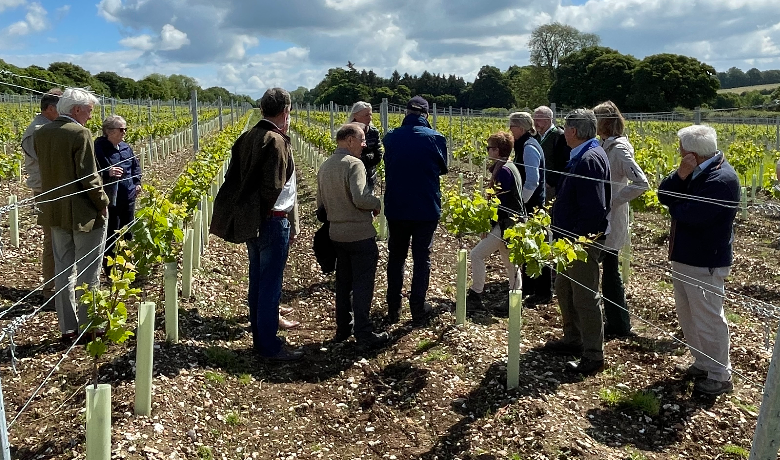The recent WCFA visit to Raimes Sparkling in Hampshire
Posted on Thu, May 30, 2024 10:25 AM

We could have been in Epernay: spring sunshine bounced on the soft green leaves of row upon row of vines growing on thin chalky soil, as we sat in a chic tasting barn comparing a classic sparkling wine with a Blanc de Noir from the same vineyard whilst nibbling cheese and olives. But we had not had to travel quite as far as northern France: we were in Hampshire, sampling some of the prize-winning produce of the Raimes Vineyard with our host, Augusta Raimes and an enthusiastic group of Liverymen, alumni and guests.
Gussie whose father is an alumnus of the ACABM course who still meets up with his cohort is the fifth generation of her family to farm here and the first to grow wine. This bold diversification came about after the family was approached some 15 years ago by two separate parties interested in buying their land to plant vines, having identified the chalk soil as being of the same rock formation that runs under the Channel and across the Champagne region. The land was not for sale, but a new idea was born and soon after, Gussie went to Plumpton College to train in viticulture. The first vines were planted in 2011 and their wines have been winning prizes since 2016.
On a tour of the vineyard, Gussie explained some of the challenges that grape-growers in Britain face. Firstly, it is incredibly labour-intensive: much of the work is done by hand, including pruning, de-leafing and the all-important harvest. Post-Brexit, it is more difficult to find suitable workers and although some of the Raimes team are local people who now return year after year, labour remains a challenge. Secondly, the weather must play ball: ideally the vines want a cold, dry winter to promote dormancy; a warm, wet spring to reduce the risk of frost; a sunny June for flowering and a long, warm summer and autumn for fruit maturation and harvest. Frost is a serious threat, but the preferred solution here is surprisingly low-tech: they favour using bougies, which are large candles set out at intervals along the rows, creating just enough heat and air movement to ward off the risk of frost damage to vulnerable buds.
We were introduced to the three classic champagne grapes: chardonnay, pinot noir and pinot meunier (the latter two being black varieties). Each is harvested, pressed and matured separately and the real skill comes when Gussie tastes the three still wines and blends them for final maturation in the bottle into either a classic or rose sparkling wine using all three grapes, or a Blanc de Noirs, which is a blend of the two black varieties. The vineyard also produces a Blanc de Blanc, which is 100% chardonnay. Climate change is already having an impact on sparkling wine production as summer temperatures rise in France, forcing earlier harvests which can adversely impact taste and quality. For now, this represents an opportunity for British growers and some French houses have already bought land in England and the USA to spread their risk.
Back in the tasting barn we tried to decipher notes of jasmine and elderflower in the nose as we compared the green apple freshness of the classic wine with the red apple complexity of the Blanc de Noirs. A delicious lunch platter of cheese, charcuterie and bread was the perfect accompaniment, and it was tempting to simply stay there for the rest of the day. Sadly we had to leave, after our Master Guy Brogden had thanked Gussie and her team for the fascinating tour and excellent hospitality. Thanks also to the Assistant Clerk Duncan Couper for organising such an enjoyable outing. Next time I shall organise a driver.
Kate Russell, Liveryman (CRL 2005)